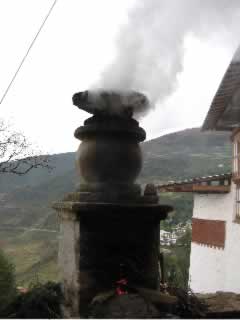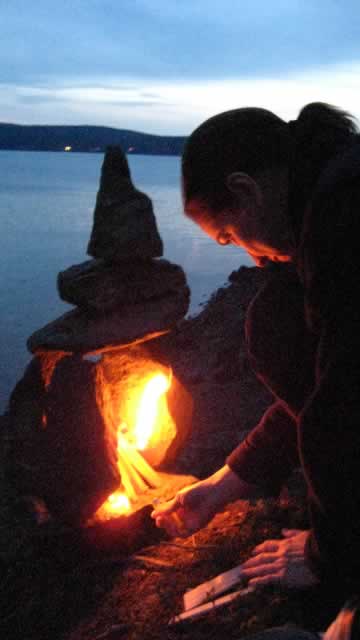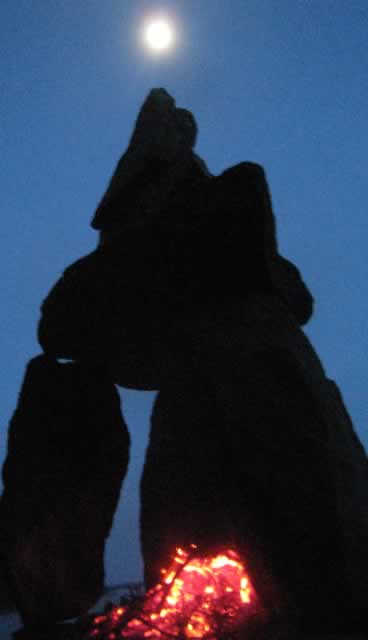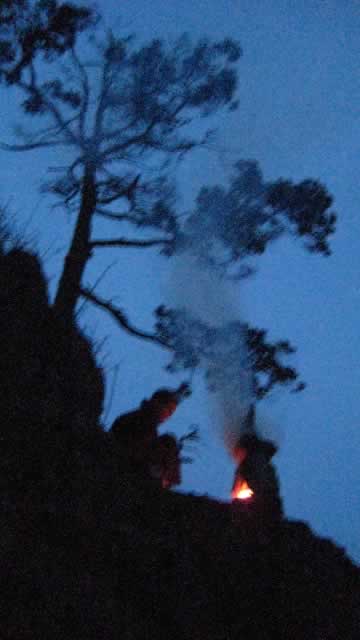
THE EXAMINATION OF INTENTION, PASSAGE AND MEANING—
THE BRAND, THE STRATEGY, THE JOURNEY.
IF YOU’RE LOOKING TO FIND THE DEEPER SIDE OF BRANDS, WHAT ARE THE RITES OF PASSAGE—GETTING THERE: CLOSER TO SOUL, HEART, INTENTION, DIRECTION?
CAN BRANDS LIVE—could they be alive?
Brands are as human as the foundations of their leadership—they are made by humans, for humans—the maker DNA is embedded in the brand, story, premise and drives positioning.
THE QUEST FOR THE
SOUL OF THE THING.
Studying in Iceland, I learn more about what the “thing” is.
What is a thing?
As a student of words—from my middle school years, studying Latin, I’ve wondered about the farther reach in the meaning of words, the linguistic roots of sounds, their uses, history and chromosomal legacy. A thing—because sometimes, what happens is that approaching a brand, people think of it as a kind of thing, a mechanical exercise, a commercial engine—yet there is more to it.
T H I N G
Old English: Ãlthing “meeting, assembly,” later “entity, being, matter” (subject of deliberation in an assembly), also “act, deed, event, material object, body, being,” from Proto Germanic: *thengan “appointed time” (cf. Old Frisian: thing “assembly, council, suit, matter, thing,” Middle Dutch: dinc “court-day, suit, plea, concern, affair, thing,” Dutch: ding “thing,” Old High German: ding “public assembly for judgment and business, lawsuit,” German: ding “affair, matter, thing,” Old Norse: Ãlthing “public assembly”). Some suggest an ultimate connection to the Proto Indo European root *ten–“stretch,” perhaps on notion of “stretch of time for a meeting or assembly.”
S T R E T C H
What I ponder is the concept of the thing as a notion of time, a construct of place, as alluded to above—and an enterprise can work like that as well. And, as we consider it, the thing is a point of contemplation, it’s a meeting place, of mind, memory and people’s tenuous stretch on imagination, embracement and recollection: the reach-out—that stretch, that moment, when reflection takes place. Stories shared, sentiments gathered.
And, it’s about the object—the thing that is held. And the meaning, in memory.
O B J E C T
1398, “tangible thing, something perceived or presented to the senses,” from Middle Latin: objectum “thing put before” (the mind or sight), neut. of Latin: objectus, pp. of obicere “to present, oppose, cast in the way of,” from ob “against” + jacere “to throw”
And, in the sensing of the thing, the object, in the arrangement of time, and the placement of the thing, it can be formed as something more meaningful. That is imbued with meaning. And I meditate on the object, the thing, as something more. Something that is transformational, something that, in action and contemplative rippling, becomes some thing different. It deepens.
It is infused, in
the conception of ritual.
R I T U A L
1570, from Latin: ritualis “relating to (religious) rites,” from ritus “rite” (see rite). The noun is first recorded 1649. Ritualistic first recorded 1850.
Which, in turn, is
R I T E
c.1315, from Latin: ritus “religious observance or ceremony, custom, usage,” perhaps from PIE base *re(i)– “to count, number” (cf. Gk. arithmos “number,” O.E. rim “number”).
This is the ritual, the rite, the counting of the days and the passage of things, newly imbued with content and meaning. Anything can be there. It’s up to you.
And this is about meaning. And the newly finding of it. The meaning in the thing, the rite of the object.
M E A N
Old English: mænan “to mean, tell, say, complain,” from Western Germanic: *mainijanan (cf. Old Frisian: mena, Du. menen, German: meinen to think, suppose, be of the opinion”), from PIE: *meino– “opinion, intent” (cf. O.C.S. meniti “to think, have an opinion,” Old Irish: mian “wish, desire,” Welsh: mwyn “enjoyment”), which is probably from base *men– “think.” Meaningful first attested 1852.
Being with my girlfriend, we explored [and continue to examine] the idea of ritual, in lamenting, in memory, the decade old passing of her sister. And my brother.
We keep at these investigations—committing to the journey of remembrance. And meaning and rite.
Finding, then, the form of content.
And we keep coming back to that meditation.
We build our own altar, *altaring time, remembering the thing that started it all—your beginnings and the meditation that could come from it: at the altar that is made, over and over—one place, another, at the instance of choosing.
Make your own sacred place.
The sanctus, is—of course—what you choose to value, but in the journey to find the deeper—whether of story, journey, brand or direction of pathway, you have to “be-lieve.” As we’d noted earlier, belief is.
Anywhere you choose to remember.
Her idea was to acknowledge, but something that gestured to our experience together in the Himalaya, exploring the monasterial spaces of that extraordinary kingdom Bhutan, we witnessed the rituals of smoke and oblation.
And she envisioned creating something similar, like the Bhutanese stupa-like altar and fume platform.

The smoke, said over prayers, sends those offerings skyward. So too, her idea and inspiration — for inspiration, as well, is of the breath.
I N S P I R A T I O N
c.1303, “immediate influence of God or a god,” especially that under which the holy books were written, from OldFrisian: inspiration, from LateLatin: inspirationem (nom. inspiratio), from Latin: inspiratus, pp. of inspirare “inspire, inflame, blow into,” from in-“in” + spirare “to breathe” (see spirit).
And, too, the infusion of spirit.
c.1250, “animating or vital principle in man and animals,” from Old French: espirit, from Latin: spiritus “soul, courage, vigor, breath,” related to spirare “to breathe,” from PIE *(s)peis– “to blow” (cf. O.C.S. pisto “to play on the flute”). Original usage in English mainly from passages in Vulgate, where the Latin word translates Greek: pneuma and Hebrew: ruah. Distinction between “soul” and “spirit” (as “seat of emotions”) became current in Christian terminology (e.g. Greek: psykhe vs. pneuma, Latin: anima vs. spiritus) but “is without significance for earlier periods” [Buck]. Latin spiritus, usually in classical Latin “breath,” replaces animus in the sense “spirit” in the imperial period and appears in Christian writings as the usual equivalent of Greek pneuma. Meaning “supernatural being” is attested from c.1300 (see ghost); that of “essential principle of something” (in a non-theological sense, e.g. Spirit of St. Louis) is attested from 1690, common after 1800. Plural form spirits “volatile substance” is an alchemical idea, first attested 1610; sense narrowed to “strong alcoholic liquor” by 1678. This also is the sense in spirit level (1768).
In any object, a thing, there is spirit — and translating spirit, in intention, brings one to a point of contemplation.
To that rippling and outreach to manifestation, we built this, together. Grabbing the right stones and arranging them on the beach — then hauling them up the cliff, to this vista.

And this modeling, in balance.

And the beginnings of the fire, finding the beauty of the transition from solid, to fire, to fume, to prayers and contemplations, born on the wind.

Fire is the translation, it’s the alchemy of transformation — and, in my thinking, fire is about the beauty of the story, the hearth, the spirit in translation — meanwhile, the moon wheels in the heart of the very opening of this notation — movement, in time, passage, in contemplation.

In feeding the fire, in contemplation, there is a meditation on the self (less) and the nature of time in the passing of all things, as we know them.
E V E R Y
T H I N G
G O E S

And that moment, the thinking on the thing, the translation of the object, takes you from the one place to another place, that is infused with wonder, reflection on your place in rite, and the beauty in mystery.
M Y S T E R Y
c.1315, in a theological sense, “religious truth via divine revelation, mystical presence of God,” from Anglo-French: *misterie (Old French: mistere), from Latin: mysterium, from Greek: mysterion (usually in pl. mysteria) “secret rite or doctrine,” from mystes “one who has been initiated,” from myein “to close, shut,” perhaps referring to the lips (in secrecy) or to the eyes (only initiates were allowed to see the sacred rites). The Greek. word was used in Septuagint for “secret counsel of God,” translated in Vulgate as sacramentum.

And beauty passes on, as the moon spins through the heavens—time, transiting, ever—to a new view of things.

I offer only one thing, to the
nature of the rippling story above—and how that could relate to the inner power of brand.
Take that time,
to be there, find your thing
—go in, and see what you can find, in the metamorphosis of meaning.
Take time.
For your self. And what you’re driving, brand forward.
S E L F
Old English: self, seolf, sylf “one’s own person, same,” from Porto Germanic: *selbaz (cf. Old Norse: sjalfr, Old Frisian: self, Dutch: zelf, Old High German: selb, German: selbst, Gothic: silba), Proto Germanic: *selbaz, from PIE *sel-bho-, from base *s(w)e– “separate, apart”.
Tim | GIRVIN redrafted from Decatur, at osean
*Altaring — a word that I
coined for the making of sacramental place.
—
Explore mystery

Just what is with Tim Girvin’s etymological fluff?
As a student of Latin and ancient languages, you learn something—
that words hold deeper mysteries in their meaning,
that takes you
right up to the thing.